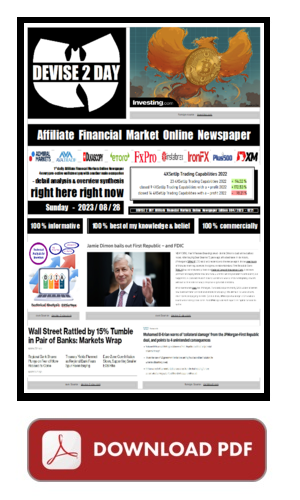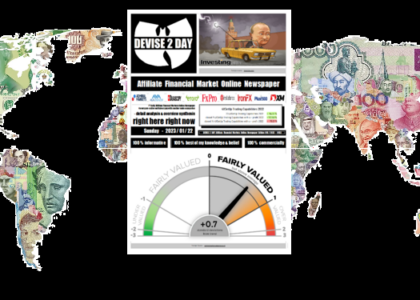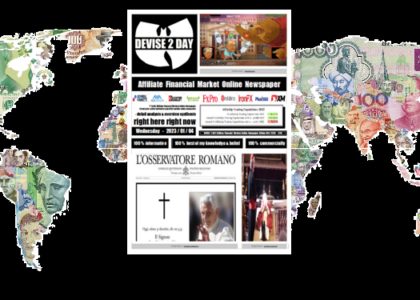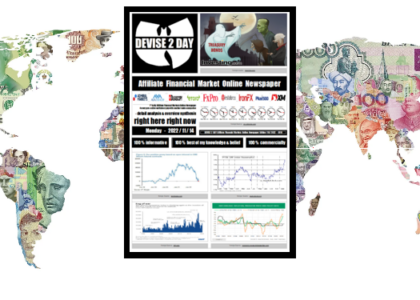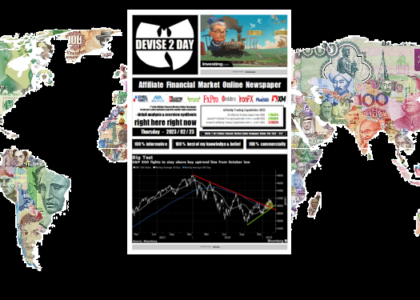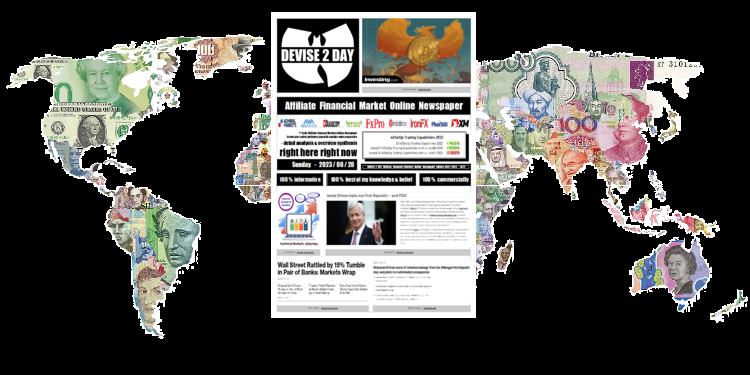
2023/05/02 (221) Column
I Am Not Writing Any Daily Colums
I’m Currently In Negotiations With A Financier Who Might Possibly Will Finance
Our Daily DEVISE 2 DAY Affiliate Financial Market Online Newspaper All By Himself !?
That`s Why I Don’t Want And/Or Can’t Take Time To Write Useful Daily Columns In The Next Weeks …
The last D2D Edition, in the current format and/or design, will therefore appear on Thursday, May 11, 2023 for the time being. And then back again, regardless of my current negotiations, then at the latest from Sunday, September 03, 2021, again for all interested financial market participants. Whether in the same format and/or also affiliate partners or even a new individual financier !? I don`t know yet ?! We will – one way or another – experience this together from September 2023. So a big THANK YOU to all loyal readers – and until Sunday, September 3rd, 2023 at the latest. If you have any further questions, contact me at Devise2Day@gmail.com …DEVISE 2 DAY 48h
– Last News About What Drives The News Media
UKRAINE WAR:
Prigozhin’s crass video message!
Vladimir Putin will certainly not like that
According to US figures, more than 20,000 Russian fighters have been killed and 80,000 others injured in the war in Ukraine since December. Around half of the dead belonged to the Wagner mercenary group, said US National Security Council spokesman John Kirby on Monday, citing US intelligence information. In an interview published on Sunday, Wagner boss Yevgeny Prigozhin warned of a possible “tragedy” for Russia in view of the expected counter-offensive by Ukraine. “Russia’s attempt at an offensive in the Donbass, largely via Bakhmut, has failed,” Kirby said. “Russia has not managed to conquer really strategically important territory.” Russia is paying a “terribly, terribly high price”. Many of the fighters in the Wagner mercenary group were ex-prisoners who were poorly trained and sent to war without adequate military leadership, Kirby said. Kirby did not provide any information about losses on the Ukrainian side. Ukraine must decide for itself whether to provide information on dead and injured soldiers, he said. “They are the victims here. And Russia is the aggressor.”
The fighting in Ukraine in recent weeks has focused primarily on the Donbass in the east of the country. Bachmut in particular is the focus. Russian units and the Ukrainian army have been fighting bitterly there for months for the city. According to their own statements, the Russian fighters now control about 80% of Bakhmut.
Wagner boss Prigozhin warned on Sunday that Ukraine’s expected counter-offensive could become a “tragedy” for Russia. Prigozhin said he expected Ukraine’s counteroffensive to begin in mid-May. The mercenary boss had again complained about the insufficient supply of ammunition to his fighters and once again blamed the Russian army leadership for this.DEVISE 2 DAY 48h
– Last News About How Drives The Price Action
Bank failures, debt drama, interest rates:
The Atmosphere on the Titanic is bombastic!
Three of the four biggest bank failures in US history happened in the last two months (JP Morgan had to buy the First Republic Bank over the weekend), the US debt ceiling has to be raised from June 1st (so political drama ahead!) , and at the same time interest rates are currently as high as they have been since 2007. And how are the markets reacting to this? On Wall Street, the market width is currently worse than it has been since 1999, the fear barometer VIX is as low as it was last at the all-time high of the S&P 500. So there is a bomb atmosphere on the Titanic – apparently there are no risks, one ignores the bank failures. Such phases go well until they no longer go well – but the chance-risk ratio is now anything but favorable. Focus today on US JOLTs jobs data, tomorrow the Fed, Thursday Apple numbers and Friday US jobs data.
Hedge fund legend Druckermiller and the crash of 1987!
Hedge fund legend Stan Druckenmiller was asked why he bet the stock market would fall before the 1987 crash. His arguments at the time: the Fed had raised interest rates sharply, the valuations, especially of the large and heavily marketed stocks, were extremely high. In addition, the earnings yield on US stocks is very low compared to safe US government bonds, and the rally before the crash in 1987 was only driven by very few large stocks. If one compares these arguments from 1987 with the situation today, one realizes almost with horror: all of these points are also the case at the moment! Of course, this doesn’t necessarily mean that something similar to what happened in 1987 will happen – but the potential for a sharp correction in the stock markets is there if the Druckenmiller pattern takes hold! Is the First Republic Bank the trigger – the stock crashes to a new all-time low, the US banking crisis seems to continue to escalate.Forex 10Y Government Bond Yields Commodties Stock Markets
AUDUSD Jumps as RBA Hikes Rates CNY10Y Falls Below 2.8% Brent Crude Futures Hit 5-Week Low Sensex Hovers at Over 4-Month Peak
Turkish Lira Extends Record Low BRL10Y Hovers at Over 3-Month Low Gold Rises Above $2,010 Russian Shares Plunge in Afternoon
European Stocks Fall on Tuesday
FTSE 100 Ends Below 7,800
US Stocks Slide over Banking Concerns
Australian Dollar Jumps as RBA Hikes Rates
The Australian dollar appreciated past $0.67, hitting its highest levels in two weeks after the Reserve Bank of Australia unexpectedly raised the cash rate by 25 basis points to 3.85% at its May policy meeting. The central bank defied market expectations of an extended pause, stating that domestic inflation was still too high and that further tightening may be required to ensure inflation returns to target in a reasonable timeframe. Latest data showed that the annual inflation rate in Australia rose 7% in the three months to March, slowing from a 30-year high of 7.8% in the previous quarter but remaining at historically elevated levels. RBA officials previously indicated they were determined to do whatever was necessary to bring inflation back within the target, and said they only paused in April to gather more information.
Turkish Lira Extends Record Low
The Turkish lira weakened past 19.45 per USD in May, extending its record low amid overly-loose monetary policy, current account imbalances, and concerns regarding this month’s presidential election. The TCMB held its interest rate steady at 8.5% in its April meeting, holding the 50bps cut from February to ease financial conditions following Turkey’s earthquake. The move added to 10.5 percentage points in rate cuts since September 2021, driving the currency to plunge by 57% and lifting inflation to top at 86% in October. Meanwhile, a change in government this month could end the central banks’ liraiziation policies and pressure the lira before the eventual tightening of financial conditions and new economic framework kick in. On the other hand, the current economic policies that have caused the lira to crash will be extended should President Erdogan remain in office.Brazil 10-Year Bond Yield Hovers at Over 3-Month Low
Brazil’s 10-year government bond yield was around 12.45% in early May, not far from an over three-month low of 12.36% hit on April 27th, as investors weighed the latest batch of positive domestic data while assessing Lula’s administration plan for strengthening the country’s public finances. A GDP proxy easily beat expectations for February, while inflation slowed to the lowest since 2020 in March. On the monetary policy front, the Brazilian central bank is anticipated to hold its benchmark interest rate steady at a six-year high of 13.75% in its policy decision on May 3rd, as core inflation remains well above headline figures and the regulator’s target.
China 10-Year Government Bond Yield Falls Below 2.8%
The yield on the 10-year Chinese government bond has been decreasing since the beginning of the year and fell below 2.8% in May, a level not seen since mid-November, as investors assessed the economic recovery and speculated on the introduction of more stimulus. The Chinese economy grew 4.5% yoy in Q1 2023, the fastest pace in a year. However, the official manufacturing PMI revealed an unexpected contraction in the factory sector in April, signalling the recovery may have lost some steam. Meanwhile, the Communist Party Politburo indicates it’s too early to tighten monetary policy, as the recovery needs continued forceful fiscal and monetary support. At the same time, higher US Treasury yields prompted by the Fed’s tightening campaign have made Chinese bonds less attractive to foreign investors.
5 days ago
Brent Crude Futures Hit 5-Week Low
Brent crude futures fell more than 4% to below $76 per barrel on Tuesday, the lowest in five weeks, due to concerns of a potential recession triggered by impending interest rate hikes by major central banks. Both the Federal Reserve and the European Central Bank are expected to raise rates this week, while the Reserve Bank of Australia unexpectedly hiked the main rate today. Adding to these worries, there are signs that the Chinese economic rebound has not yet materialized, as recent PMI data indicated a decline in factory activity in April. However, there is some potential support for oil prices as OPEC+ has announcedplans to decrease output this month as part of an effort to stabilize the market.
Gold Rises Above $2,010
Gold prices erased early losses and jumped above $2,015 per tonne, approaching the 13-month high of $2,040 touched on April 13th as evidence of a slower job market and concerns over small-cap US banks triggered a fresh flight to safety ahead of tomorrow’s FOMC decision. Data from the JOLTS showed that job openings in the US fell to a near two-year low during March, adding to recent evidence that higher borrowing costs loosen the labor market. At the same time, a fresh sell-off in shares of US regional banks renewed concerns over instability in the US financial system, supporting demand for precious metals.
Sensex Hovers at Over 4-Month Peak
The BSE Sensex rose 325.6 points or 0.6% to a more than 4-month high of 61,437.8 in morning trade on Tuesday, extending gains for the eighth session in a row, supported by rises in basic metals, tech, and oil and gas. Traders were upbeat after the IMF revised higher its 2023 Asian growth forecast to 4.6% from 4.3%, due to the buoyant outlook for both China and India. Meantime, India’s factory activity grew the most in four months during April, amid solid growth in new orders and output. Markets in India also mirrored a mostly rise in their peers in Asia, with investors bracing for policy rate decisions from the Fed Wednesday. Oil & Natural Gas Corp. and Oil India rose 2.4% and 0.8%, respectively, after the government cut the windfall tax on crude oil produced at home. TVS Motor gained 0.8%, after posting a 29% yoy jump in sales. Ambuja Cements, Adani Total Gas, Tata Steel, and Uco Bank were among the companies scheduled to announce March quarter results today.
Russian Shares Plunge in Afternoon Trade
The ruble-based MOEX Russia index extended early losses and plunged 2% to close at 2,580 on Tuesday, pulling back sharply from the one-year high touched last week as the sharp decline in oil prices threaten Russia’s fiscal stability. Brent oil futures plummeted by nearly 5% in the session, pressuring major Russian oil producers to close more than 2% lower. On top of that, Novatek lost 6% as it traded ex-dividend. Besides hurting energy producers, lower oil prices reduce vital energy revenues for the Federal government, which led Moscow to mandate extraordinary tax measures on MOEX blue-chips last year so that the Russian invasion of Ukraine can be financed. Miners and metallurgists lost 2.6% on average, while banks retreated 2%.European Stocks Fall on Tuesday
European equities experienced a downturn on Tuesday, with the Stoxx 600 and Germany’s DAX both declining by over 1%. The oil and gas sector was the hardest hit, declining by more than 4% due to a drop in oil prices. BP’s shares plummeted nearly 9% after scaling back its share buyback plan, despite reporting a $5 billion profit in Q1 2023. Bank stocks also fell by more than 1%, in line with Wall Street lenders as concerns about the health of US regional banks reemerged following the takeover of the First Republic Bank by JP Morgan. Still, HSBC Holdings’ shares rose almost 5% after the bank announced a substantial increase in profits, from $8.7 billion to $12.9 billion in Q1 2023.
FTSE 100 Ends Below 7,800
Equities in London came under heavy selling pressure on Tuesday, with the benchmark FTSE 100 finishing below the 7,800 mark, dragged by losses in the energy and materials sectors. One of the biggest losers in the stock market was Pearson, which dropped more than 15%. This was due to the sharp decline in shares of Chegg, an online learning service, which plummeted by almost half after admitting that its finances were impacted by the AI chatbot ChatGPT.
US Stocks Slide over Banking Concerns
The Dow finished 360 points lower on Tuesday, while the S&P 500 and Nasdaq 100 fell nearly 1.2% and 1.1%, respectively, led by a selloff in US regional lenders as concerns about financial stability grew after the second-largest bank failure in the country’s history. Among lenders, PacWest and Western Alliance plunged by 27.8% and 15.1%, respectively. JPMorgan, which had gained traction in the previous session following the takeover of First Republic Bank, lost 1%. Adding to the bearish sentiment, JOLTS job openings reached their lowest point in almost two years raising concerns about a potential slowdown in the US economy. Investors have also shown caution in opening new positions, given the looming outcome of the Federal Reserve’s upcoming two-day meeting. Still, there was some positive news in the market as Uber shares rose by 11.5% due to strong quarterly results driven by high demand for travel and food delivery services.DEVISE 2 DAY 48h
– Where I Was Wrong, Where I Was Right
The largest bank in the US takes over the collapsed First Republic Bank in a cheap deal. For CEO Jamie Dimon, it wasn’t the first successful emergency operation – he was the rescuer back in 2008.
The largest US bank emerges as a big winner from the long weekend of the crisis. After intensive negotiations and a sometimes grueling auction, J.P. Morgan Chase won the bid for California’s ailing First Republic Bank on Monday. This should draw a line under the recent banking crisis – even if the Wall Street giant is even bigger.
The deal marks the end of another dramatic escalation in the banking sector. The First Republic, until recently a top 15 US bank, was among the US regional lenders hardest hit by the banking turmoil since March. In the wake of the collapses of Silicon Valley Bank in San Francisco and Signature Bank in New York, depositors had withdrawn en masse from smaller institutions. After the initial panic seemed to calm down, things initially looked good for the First Republic as well. But investors fled again last week after the bank announced that it had outflowed more than $100 billion in deposits in the first quarter – and that it was exploring new options.
It emerged as the winner of the auction process over the weekend, in which several other banks also participated. JP Morgen will pay $10.6 billion to the FDIC to take control of most of the San Francisco-based bank’s assets and gain access to First Republic’s coveted customer base. “Our government asked us and others to get involved – and we did,” said Dimon, who had already played a key role in the state-orchestrated sale of the collapsed investment bank Bear Stearns during the financial crisis of 2008, which was also in the course of a dramatic crisis weekends at J.P. Morgan left.
What this means for us,
who`re interested in the financial market price action?
Especially for all our open 4XSetUp Trading Capabilities? TradingView Symbol since entry target stop
long ICE-FX_IDC:EURUSD 2023/01/03 1.0545 1.1496 0.9935
long XETR:ADS 2023/02/12 139.26 170.08 121.30
TVC:US01Y 2023/03/03 4.79%
long CME:BTC1! 2023/03/20 27945 34455 25350
long CBOT_MINI:YM1! 2023/03/26 32434 35228 31148
long EUREX:FDAX1! 2023/03/28 15299 17675 12586
long BSE:SENSEX 2023/03/30 57960.09 63583.07 52516.76
short TVC:UKOIL 2023/04/20 80.75 60.30 89.05
That´s why let me just remind us all
how banks make money in the first place.
They make money from what they call the spread, or the difference between the interest rate they pay for deposits and the interest rate they receive on the loans they make.
They earn interest on the securities they hold.
They earn fees for customer services, such as checking accounts, financial counseling, loan servicing and the sales of other financial products (e.g., insurance and mutual funds).
And now comes the crucial point, which George Soros, my literary ego, described as Reflection Theory. The ambivalent relationship between traders and/or investors about the fundamentals and price action. Which, in his opinion and/or in my opinion, is always overrated or underrated. What we have to watch in the coming days and/or weeks! To realize if we us while these days at a price action bottom. But don`t undestand me wring; i`m not thinking about it (yet) to just declare another bull market on US Wall Street. But at least our 4XSetUps long positions don’t close – so stay long for the time being in the us american DOW Future, in our german DAX Future, and/or indian stock market, the SENSEX Index.
Which is why I want to take a quick look at the gold price again at this point. Which, if you like, also stands as an anti-cyclical indicator for the banking system, for the fiat money system.
To find out what kind of price action scenario we are currently in?
Today, Gold Rises Above $2,010
Gold prices erased early losses and jumped above $2,015 per tonne, approaching the 13-month high of $2,040 touched on April 13th as evidence of a slower job market and concerns over small-cap US banks triggered a fresh flight to safety ahead of tomorrow’s FOMC decision. Data from the JOLTS showed that job openings in the US fell to a near two-year low during March, adding to recent evidence that higher borrowing costs loosen the labor market. At the same time, a fresh sell-off in shares of US regional banks renewed concerns over instability, supporting demand for precious metals.
good morning, good day, and/or good night
at whatever time, wherever you are !
right here right now :

